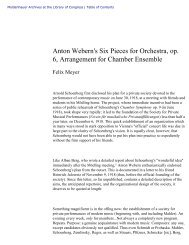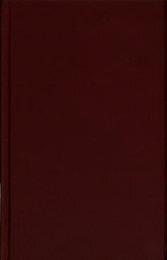Country Profile: Cuba - American Memory - Library of Congress
Country Profile: Cuba - American Memory - Library of Congress
Country Profile: Cuba - American Memory - Library of Congress
Create successful ePaper yourself
Turn your PDF publications into a flip-book with our unique Google optimized e-Paper software.
<strong>Library</strong> <strong>of</strong> <strong>Congress</strong> – Federal Research Division <strong>Country</strong> <strong>Pr<strong>of</strong>ile</strong>: <strong>Cuba</strong>, September 2006<br />
The air force still has a sizable inventory, but it, too, suffers from obsolescence and critical<br />
shortages <strong>of</strong> spare parts. In 2006 the air force had 127 combat aircraft <strong>of</strong> Russian make, only<br />
about 25 <strong>of</strong> which were operational. The air force also had 87 Russian-made helicopters <strong>of</strong><br />
various types. Air defense weapons included 300 low- to medium-altitude SAMs (surface-to-air<br />
missiles) <strong>of</strong> various types and antiaircraft guns <strong>of</strong> unknown quantities. As <strong>of</strong> 2006, the inventory<br />
included two new mobile versions <strong>of</strong> the Soviet-era S–75 (SA–2 Guideline) and S–125 (SA–3<br />
Goa). Army aviation had about 65 Mi-type attack, utility, and antisubmarine warfare helicopters,<br />
about 63 <strong>of</strong> which were in service. Naval aviation included 18 Russian helicopters <strong>of</strong> unknown<br />
operational status. The navy also had a substantial but increasingly obsolescent inventory <strong>of</strong><br />
equipment, which included about seven coastal patrol craft, four missile craft, six mine<br />
countermeasures craft, and one hydrographic survey vessel. Coastal defense equipment included<br />
the truck-mounted SS–N–2B Styx and various artillery pieces. Naval spare parts were in critical<br />
shortage.<br />
Military Service: Since 1963 all male citizens between the ages <strong>of</strong> 16 and 45 have been liable<br />
for military service. The initial period <strong>of</strong> military training originally lasted three years, between<br />
the ages <strong>of</strong> 17 and 20. In 1991 active duty was reduced to a two-year tour. Reservists serve 45<br />
days per year.<br />
Paramilitary Forces: Active paramilitary forces totaled 26,500 in 2006. Paramilitary forces in<br />
general include a civil defense force <strong>of</strong> 50,000 and the Youth Labor Army (Ejército Juvenil de<br />
Trabajo—EJT). The EJT’s membership ranges from 65,000 to 100,000, depending on the source<br />
but was approximately 70,000 in 2006. Primarily an organized labor force under the control <strong>of</strong><br />
the Joint General Staff, the EJT has military training and equipment. By far the largest<br />
paramilitary force is the Territorial Troops Militia (Milicia de Tropas Territoriales—MTT),<br />
which is <strong>of</strong>ten described as having 1 million reservists. The MTT is organized into about 200<br />
regiments comprising approximately 1,000 battalions. Primarily an infantry force, the MTT<br />
includes mounted units and some artillery and antiaircraft elements. The 6,500-member Border<br />
Guard Troops (Tropas de Guardafronteras—TGF) may also qualify as a paramilitary force.<br />
Foreign Military Forces: Since 2000 the Chinese reportedly have operated two signals<br />
intelligence (SIGINT) facilities, located at Santiago de <strong>Cuba</strong> and Bejucal, for the purpose <strong>of</strong><br />
monitoring military communications networks within the United States. All Russian combat<br />
troops have been withdrawn from <strong>Cuba</strong>, but some SIGINT troops and military advisers<br />
reportedly remain. The last major Russian presence on the island was the Lourdes SIGINT<br />
station; its announced closure in October 2001 deprived the Castro government <strong>of</strong> as much as<br />
US$200 million in annual rent.<br />
Military Forces Abroad: The <strong>Cuba</strong>n military does not participate in peace support operations<br />
and is not known to have any forces abroad, other than an unknown number <strong>of</strong> advisers in<br />
Venezuela. Since the mid-1990s, <strong>Cuba</strong> has sent Special Forces <strong>of</strong>ficers to Vietnam for training.<br />
<strong>Cuba</strong> reportedly considered a request from the government <strong>of</strong> the Solomon Islands in May 2000<br />
for <strong>Cuba</strong>n intervention in the interethnic civil war that was engulfing the islands. <strong>Cuba</strong> initially<br />
indicated a willingness to provide aid and support measures to help alleviate the fighting in<br />
return for diplomatic recognition and involvement in exploitation <strong>of</strong> the Pacific nation’s mineral<br />
assets, but nothing came <strong>of</strong> the talks after regional diplomatic protests.<br />
31



![Albert Einstein Papers [finding aid]. Library of Congress. [PDF ...](https://img.yumpu.com/21604228/1/190x245/albert-einstein-papers-finding-aid-library-of-congress-pdf-.jpg?quality=85)





![American Colony in Jerusalem Collection [finding aid]. Library of ...](https://img.yumpu.com/17941275/1/190x245/american-colony-in-jerusalem-collection-finding-aid-library-of-.jpg?quality=85)



![Piccard Family Papers [finding aid]. - American Memory - Library of ...](https://img.yumpu.com/17941234/1/190x245/piccard-family-papers-finding-aid-american-memory-library-of-.jpg?quality=85)


